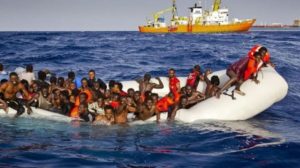Is the global refugee crisis easing?
 The number of people seeking asylum in the European Union almost halved in 2017, the latest data reveals, pointing to the first signs that the global refugee crisis may be easing.
The number of people seeking asylum in the European Union almost halved in 2017, the latest data reveals, pointing to the first signs that the global refugee crisis may be easing.
At the height of the crisis, more than 1.2 million people applied for international protection in 2015 and again in 2016. Last year, just 650,000 first-time asylum applicants were registered, a number comparable to levels recorded in 2014, according to data from the European statistics agency Eurostat.
Most asylum applicants came from Syria: 102,400 in 2017, a drop of 69 per cent from the 334,865 who applied in 2016.
Asylum seekers from Iraq also dropped by 62 per cent from 128,620 applicants in 2016 to 48,320 in 2017, according to Eurostat.
Germany accounted for 31 per cent of all first-time applications in the EU, followed by Italy (20 per cent), France (14 per cent) and Greece (9 per cent). Nearly one million applications for asylum were still pending in 2017 — a figure that has barely moved since the height of the refugee crisis in 2015.
Meanwhile IOM, the UN Migration Agency, reports that 12,983 migrants and refugees have entered Europe by sea through the first 11 weeks of 2018, with about 47 per cent arriving in Italy and the remainder divided between Greece (30 per cent) Spain (22 per cent) and Cyprus (less than 1 per cent). This compares with 21,058 at the same time in 2017.
The death toll among migrants crossing the Mediterranean may also be easing.
IOM’s Missing Migrants Project (MMP) reported a boat capsized off the island of Agathonisi last week with 16 deaths and three people rescued.
This is the first incident recorded on the eastern Mediterranean route since 25 December 2017 – a stretch of 85 days without a fatality on this route, which in 2015 saw 850 fatalities for the year.
MMP has reported on Monday that deaths on the three Mediterranean routes – 495 as of March 18 – remain down about 9 per cent below their total at this same time in 2017, when 544 migrants had been counted as drowned or missing in the waters between Africa, the Middle East and Italy.
The 495 deaths on the three Mediterranean routes include, this week, 12 migrants who died in the Alborán Sea between Morocco and Spain, as reported by Spanish NGO Caminando Fronteras.
The Moroccan Navy also rescued 22 people in the same operation on 12 March while recovering those 12 bodies from a sinking boat. MMP also reported that on 28 February, the Algerian Coast Guard recovered the remains of a man five nautical miles northeast of Plage de Bouzedjar.
Worldwide, IOM’s Missing Migrants Project has recorded 779 migrant fatalities in 2018, compared with 1,100 through 18 March last year.
Besides these latest Mediterranean drownings, MMP reported that two migrants died and seven were injured in a car accident in Greece’s northern city of Xanthi on 17 March.
MMP also reported that in Southeast Asia, one man was killed by a landmine blast on the Myanmar-Bangladesh border on 15 March, while his wife and four children were injured.
On 19 March, the bodies of two Vietnamese migrants were recovered from a beach in Taiwan’s eastern coast, while five survivors were rescued by Taiwan’s Coast Guard. One of them reportedly died when receiving medical treatment.
The MMP team also recorded one death between West Africa and Spain: on 16 March, the remains of a migrant were found near Playa de la Madera, in Lanzarote, Canary Islands.
Laurie Nowell
AMES Australia Senior Journalist












